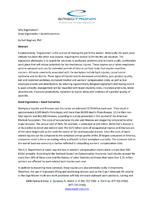Nanion's Patchliner Exceptionally Well Received by Academic Ion Channel Core Facilities
Share:
Munich, Germany; The new year has started well for Nanion; in the first weeks of 2011 more than five Patchliners were sold and shipped to academic institutions intended for advanced ion channel research and screening projects, and are soon to be followed by the first SyncroPatch 96 shipment and installation.
The Patchliner, a highly versatile patch clamp screening platform for increased throughput, has been on the market since 2006. Patchliner customers are evenly distributed over pharmaceutical industry, contract research organizations and academic institutions because of the flexibility and increased throughput of the platform.
Again highlighted by the recent sales, the Patchliner is a much appreciated tool for academic research, mainly because of the high data quality obtained with the platform, and its vast experimental freedom.
Together with three additional Principal Investigators, Dr. Todd Scheuer and Dr. William Catterall invested in both the Patchliner and the Port-a-Patch to form a core facility for ion channel screening and research at the University of Washington, Seattle, USA.
Dr. Todd Scheuer, Research Professor at the Department of Pharmacology, University of Washington, Seattle, says: "We invested in the Patchliner because of its great experimental flexibility. The diversity of our research projects requires a platform capable of high performance with a multitude of ion channels and cells, as well as experimental possibilities such as action potential- or primary cell recordings."
In the southern hemisphere, Dr. Steven Petrou, Associate Director at the Florey Neuroscience Institute, and Associate Professor at the Centre for Neuroscience, The University of Melbourne, Australia, invested in multiple Patchliners for the ion channel core facility there.
Dr. Steven Petrou, says: "We recently bought several Patchliners to cover the needs of our neuroscience research projects and to establish an ion channel core facility for the wider ion channel research community. Indeed, the Patchliner has unique experimental features including temperature control, internal perfusion and fast solution exchange. This in combination with supporting giga-Ohm seals and having a throughput corresponding to 100 dose responses per day convinced us that Patchliner will be of great use in our current, but also future research projects."
Dr. Niels Fertig, CEO of Nanion says: "We are of course very pleased with this year's sales trend, which reflects the customers' appreciation of our high fidelity patch clamp platform and the strong scientific background of our support team. As a consequence, we have expanded the US-office to match the demand for demonstration and to cover possible assay support. Further, the installation of another six Patchliners in top-notch academic laboratories confirms its strength and unparalleled experimental features."
About Nanion:
Nanion Technologies GmbH is a German Private Limited Company and was founded in 2002 as a spin-off from the Center for Nanoscience (CeNS) of the University of Munich. Nanion's team has developed and globally established two highly successful automated patch clamp instruments as enabling tools for sophisticated and high throughput applications for ion channel research and drug discovery.
Nanion's instruments use planar patch clamp chips which replace the traditional glass pipette used in the technique of patch clamping. Nanion was nominated in 2007 for Germany's most prestigious innovation award the Deutscher Zukunftspreis (German Future Prize, Federal President's Award for Technology and Innovation).
About Dr. William Catterall
William Catterall, Ph.D., is professor and Chair of the Department of Pharmacology, University of Washington, Seattle, WA, USA. Research in this laboratory is focused on the voltage-gated sodium and calcium channels which are responsible for action potential generation in nerve and muscle and for initiation of synaptic transmission. The structure and function of these ion channels are studied, and their regulation by physiological pathways, drugs, and neurotoxins, and their role in coordination of electrical excitability and synaptic transmission in neurons.
Clinically important drugs, including local anesthetics, antiarrhythmics, antiepileptics, and calcium antagonists alter the properties of voltage-sensitive ion channels. Currently investigating the sites and mechanisms are investigated by which these drugs alter the properties of ion channels in order to define the mechanism of drug action at the molecular level and identify common themes which may be important in development of new therapeutic agents. Recent work has led to the identification of the receptor sites for the calcium antagonist drugs on calcium channels and the receptor sites for local anesthetic drugs and multiple neurotoxins on sodium channels.
About Dr. Todd Scheuer
Todd Scheuer, Ph.D. is Research Professor at Department of Pharmacology, University of Washington, Seattle, WA, USA. The research interests are targeted at two families of related proteins, the voltage-gated sodium channels and the voltage-gated calcium channels. They are both part of the ion channel superfamily, the members of which are critically important for transmembrane signaling.
Professor Scheuer describes his research goals: "We are interested in many facets of these molecules and their role in biology. Most fundamentally, we are interested in the structure and function of the molecules themselves and how that structure allows them to respond to cell membrane voltage. We are interested in how the channels are blocked by drugs and toxins, both because of the information it provides for making more effective drugs and because the shapes of rigid blocking compounds gives us information about the structure of the channel receptor. Modulation of these channels is fundamental to controlling physiological activity in a broad variety of cells and we are interested in the molecular signaling complexes that support that signaling and the pathways involved. Recently our interests have been increasingly directed to specific roles of these channels in biology and disease. In one project, we study populations of clams chronically exposed to paralytic shellfish toxins released by the dinoflagellates that cause red tides in the ocean. The sodium channels of these clams have responded to the toxin by incorporating amino acid substitutions that make them resistant to the toxins. Disease-related projects target understanding the role of defective sodium channels in epilepsy and muscle myotonias".
About Dr. Steven Petrou
Associate Professor Petrou is an Associate Director and Head of the Florey Neuroscience Institutes' Division of Epilepsy, and heads the Laboratory of Ion Channels and Human Disease, a multidisciplinary team of researchers with a focus on revealing fundamental mechanisms of disease genesis in the central nervous system. Current major areas of investigation centre on the development and characterization of genetically engineered mice models for the study of human familial epilepsy. He works closely with industry and has several patents for his discoveries. In addition to his many roles within the Florey Neuroscience Institutes and the University of Melbourne, he serves on the editorial board of the Journal Neurobiology of Disease and the Investigators Workshop Committee for the American Epilepsy Society.
Contact details: Niels Fertig, CEO, Phone: +49 89 2189 97972, Email: info@nanion.de, Web: www.nanion.de




